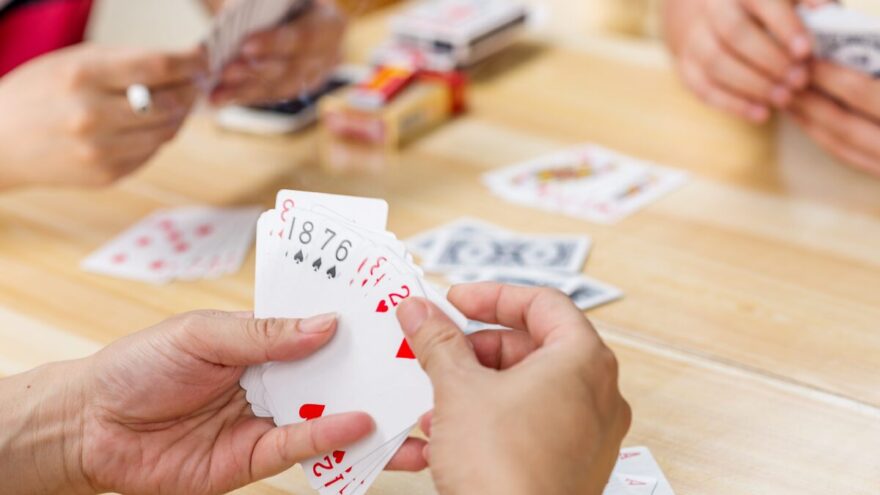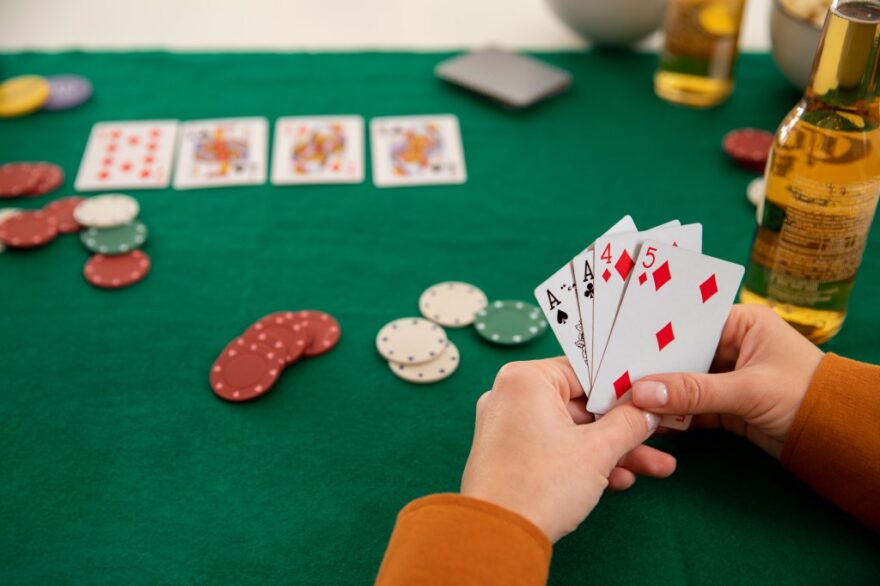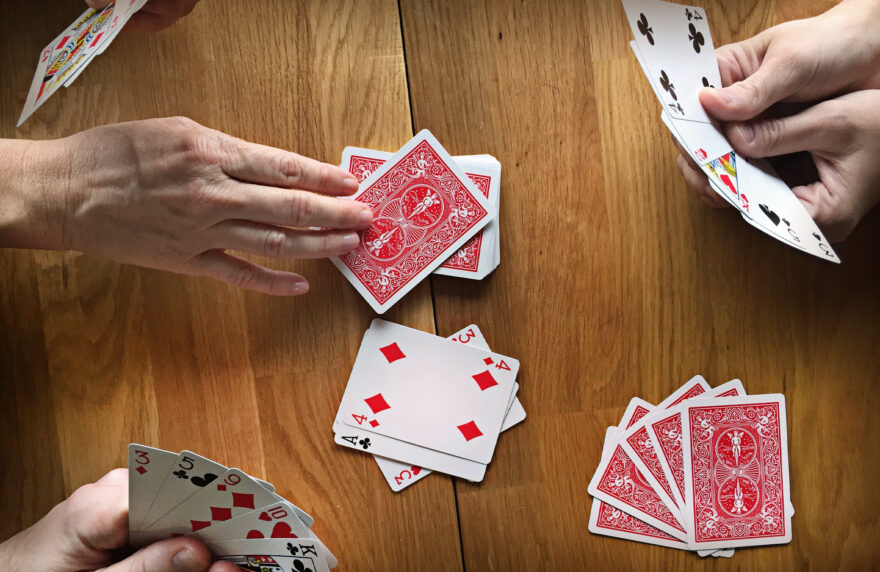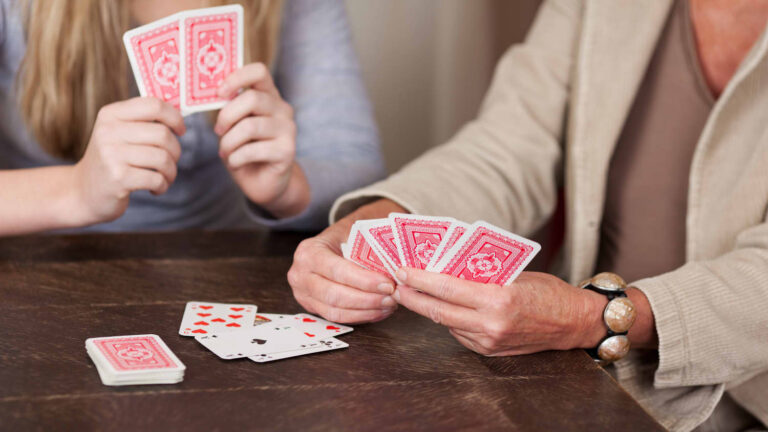The earliest stories of card games come from China, in the 9th century. From there, playing cards travelled around the world, along trade routes and into the hands of everyone from government officials and merchants to soldiers and sailors. By the 14th century, playing cards were popular in Europe and North Africa.
The playing cards of the past vary dramatically in size and decoration from the cards of today. Some early playing cards were even circular! The games they were used for are very different from today’s popular card games as well. To put it into perspective, we often think of poker as the traditional card game but it has only been played since the 1820s.
Even with all of the modern entertainment options surrounding us, people everywhere still play cards as a hobby. Even when they’re competitive, card games have a way of bringing people together, and learning to play simple card games such as war or go fish is a happy childhood memory for most of us.
The most beloved card games have an international appeal but each country has its own games and card-playing culture. In this article, we’ll look at some of the ways in which card games have evolved within a country’s culture.
Edmond Hoyle and standardization

If you’ve ever played poker with a new group of friends or joined in an established card game group, you’ve probably run into “house rules”. House rules are unofficial rules set up by a group of players or card game host. No matter how helpful or fun these rules can be, they’re confusing and annoying for new players to pick up on.
In the early days of card games, that’s how it always was. There was no standardization of rules because they were still being established or had strong regional differences. In the 1700s, writer and card enthusiast Edmond Hoyle began teaching people how to play whist, and created an official rules pamphlet. He followed this up with guidelines for playing the other popular games of the era: backgammon, piquet, chess and quadrille.
Hoyle’s rule books have been continuously updated and republished since the 18th century. He is largely responsible for the standardization of card games in the United Kingdom, its empire, and the United States. Hoyle was so important to establishing the rules as we know them that even today, card game rule books published by other authors will use his name in the title.
If the name Hoyle sounds familiar but you’ve never seen one of his rulebooks, it’s probably because Hoyle cards remain one of the leading brands of playing cards.
Baccarat

The evolution of baccarat has led to the creation of three different version in the three regions where it is most popular. The origins of baccarat are unclear but we do know for certain that it was popularized in France during the 1800s. It was at the center of a royal scandal in Britain in the 1890s, was James Bond’s favorite game in the Ian Fleming novels and has become a Las Vegas game of choice for high rollers.
In France, the game has remained largely the same as the original version. It is referred to as baccarat chemin de fer in order to distinguish it from the other, newer versions. It is a slightly quicker version than others, which might be a key to its lasting popularity. The game is played by the players against the banker, and the banker position passes around the table when the current banker loses.
In the United States, the United Kingdom and former Commonwealth countries, the version of baccarat that is played is called punto banco. The name comes from the version’s birthplace in Havana. The primary difference between punto banco and other forms of baccarat is that it’s a house-backed game. This means that the casino acts as the banker in the game and players bet on either the player (“punto”) or the bank (“banco”) winning.
Punto banco has more complicated rules than chemin de fer. One of the most important rules deals with when a third card is drawn and what happens next. It depends on the value of the cards on the table and who holds them. The third card rules at LeoVegas help to clarify these rules, which can be very confusing for new players.
The third version of baccarat is actually considered an evolution of the game instead of simply a variation. It is called Macao and has roughly the same form as baccarat, with some important changes that make the game move even faster. The biggest one is how many cards are used – chemin de fer and punto banco use six decks of cards while Macao only uses two. Macao is mainly played in Russia.
Rummy

The game of rummy is another one with a blurred history. Game historians have located the origins of rummy in either Mexico or China, sometime in the 19th century. No matter where it started, rummy and its many variants have all evolved and become popular in the United States.
Rummy is a set-building game where players are all racing to build a hand composed of a ‘set’ of cards, either all the same rank or a series in the same suit (for example 4, 5, 6 and 7 of diamonds would be a run). The combination of a simple base game, widespread popularity and the sheer size of the United States resulted in tons of variations appearing.
In the United States, the leading variants of rummy are gin rummy, 500 rum, contract rummy and canasta. As the card game was introduced to other countries around the world, they all developed their own unique variants as well. Desmoche is the variant from Nicaragua, Treppenrommé is played in Germany and Austria, Kalooki is played in Jamaica and Marriage is the version played across Nepal and Bhutan.
Rummy is perhaps the best game to demonstrate how games evolve in different countries because it is so widely played and there are so many variants.
Related Posts:
- 20 Best Gaming Headset Under 50$ 2024 - for PC, PS4,…
- 10 Best Climbing Harness of all Time 2024 - Opinion…
- 15 Best Dog Food For Allergies 2024 - Adult, Puppy…
- Displaying China Collections - 8 Tips and Creative Ideas
- 12 Best Car Wax For Black Cars 2024 - Protection and…
- Top 10 Best Paint Sprayer For Cabinets 2024 -…







